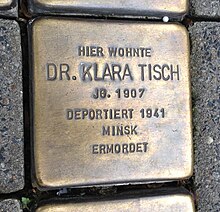Clare table
Clare Tisch , also Klare or Klara Tisch, (born January 14, 1907 in Elberfeld (today: Wuppertal ); lost November 1941 in Minsk ) was a German economist and victim of the Holocaust.
Life
Clare Tisch was the daughter of the Elberfeld merchant Leo Tisch and his wife Adele (née Rubin). She attended Lyzeum West in Elberfeld from 1913 to 1920 and then, up to graduation in 1926, the secondary school in Unterbarmen. From 1926 she studied economics in Bonn, Geneva, Berlin and then again in Bonn. In 1929 she passed her diploma examination. In Bonn, their teachers have included Arthur Spiethoff , Herbert von Beckerath and Joseph Schumpeter , in which it in 1931 as a 24-year-old with a well-received work on problems of economic calculation problem doctorate was and later from Harvard backed out. She was in correspondence with him until she was deported . The 24-year-old's dissertation is considered an “influential” (McCraw) and “remarkable achievement” ( Hagemann ) and makes her the forerunner of the so-called “neoclassical socialists” such as Henry D. Dickinson, Oskar Lange and Abba Lerner . Friedrich August von Hayek will later quote her work as well as Schumpeter in his work “ Capitalism, Socialism and Democracy ”.
She was scientifically active until 1933; at the same time she worked as Arthur Spiethoff's secretary.
Because of her Jewish descent, she could not stay at the university and worked temporarily as a repetitor, typist and clerk.
From 1936 she worked in the adoption center of the Jewish Women's Association in Wuppertal-Elberfeld. She missed several opportunities to emigrate - perhaps because of the orphans entrusted to her. Schumpeter had given her a guarantee to enable her to travel to the USA. On November 10, 1941, Cläre Tisch was deported to the Minsk ghetto together with her sisters Marie and Gerda, her brother-in-law Leo Marcus and her niece Arnhild Marcus in a group of 992 Jewish citizens from Wuppertal, Düsseldorf and Essen, where they were probably deported in 1942 or 1943 murdered.
In front of the house at Neumarktstrasse 46 in Wuppertal, where she once lived, a " stumbling block " reminds of her today . They are also remembered in the permanent exhibition of the Old Synagogue .
Works
- Economic accounting and distribution in the centrally organized socialist community, (Bonn dissertation), Wuppertal-Elberfeld 1932
- The economic sense of the previous case law of the German cartel court. Vittorio Klostermann, Frankfurt a. M. 1934
- Organizational forms of German medium-sized industry (industrial studies. Ed. V. Herbert von Beckerath; volume 3), Vittorio Klostermann, Frankfurt / Main 1934
literature
- Harald Hagemann: Clare table. In: Harald Hagemann , Claus-Dieter Krohn (ed.): Biographical handbook of German-speaking economic emigration after 1933. Volume 2: Leichter branch. Saur, Munich 1999, ISBN 3-598-11284-X , p. 714ff.
- H. Hagemann, article "Cläre Tisch", in: Robert W. Dimand, Mary Ann Dimand, Evelyn L. Forget (Eds.), A Biographical Dictionary Of Women Economists, Cheltenham 2000, pp. 426-429.
Web links
- Page on Clarification Table in the Yad Vashem Archives
- Article in the exile archive
- The “stumbling block” for Cläre Tisch
Remarks
- ^ According to Allen, she was one of Schumpeter's "favorite students": Robert Loring Allen, Opening doors. The Life and Work of Joseph Schumpeter, New Brunswick 1991, Vol. 1, p. 282; P. 109; similar to Thomas K. McCraw , Joseph A. Schumpeter. Eine Biographie, Hamburg 2008, p. 228 u. 662.
- ↑ C. Nishiyama / KR Leube (ed.), The Essence of Hayek, Stanford 1984, p. 60 ( The Impossibility of Socialist Calculation ).
- ↑ Tübingen 2005, p. 277, in the 16th chapter (“The socialist basic plan”), in which Schumpeter deals with the topic of socialist economic accounting and distribution. The work was first published in English in 1942.
- ↑ For a more recent reference cf. the work by Jesús Huerta de Soto , Socialismo, Cálculo Económico y Función Empresarial, which has been reprinted several times and has been translated into various languages . Unión Editorial, Madrid 1992, p. 217; 225f.
| personal data | |
|---|---|
| SURNAME | Table, Clare |
| BRIEF DESCRIPTION | German economist |
| DATE OF BIRTH | January 14, 1907 |
| PLACE OF BIRTH | Elberfeld |
| DATE OF DEATH | after November 10, 1941 |
| Place of death | Minsk |
